Las prótesis impresas en 3D están revolucionando el mercado médico y abriéndolo a sectores de la población que no se las podían permitir, liberalizándolas y democratizándolas.
🔝 ¿Preparado para ver los 15 proyectos más chulos de prótesis hechas con impresión 3D?
Desde la apertura del ‘open hardware’ al mundo a través de la impresión 3D, muchos makers se pusieron a tratar de mejorar la vida de los demás, y de eso queremos hablar hoy, de cómo poder hacer prótesis funcionales low-cost para los demás.
Para ello veremos qué tipo de prótesis existen y cuáles son nuestros proyectos favoritos desarrollados con las mismas, y si conoces a alguien que las necesita, poder acudir a las fuentes adecuadas y, quien sabe, unirte tú algún día a la causa 🙂
Dicho esto, comenzamos.
📖 Resumen del artículo
¿Qué son las prótesis 3D y por qué se habla tanto de ellas?

Las prótesis 3D son prótesis funcionales de diversas partes del cuerpo desarrolladas con la tecnología libre de la impresión 3D, haciéndolas asequibles a todo el mundo y ampliando su manufactura al usuario común. Esto tiene además varias ventajas que desde Bitfab queremos destacar.
✅ Las prótesis 3D son muy baratas.
Una prótesis de brazo puede gastar prácticamente 2[kg] de filamento de impresora 3D, los cuales pueden llegar con materiales semi-resistentes a 25 [€/kg]. Poder hacer una mano completa y útil por 30 euros prácticamente era inconcebible hace unos años, en los que por lo menos la inversión era de unos 500€.
✅ Se fabrican muy rápido
Su fabricación es bastante rápida, solo necesitas una impresora 3D y un modelo 3D de lo que quieras hacer. Una mano puede llegar a a tardar unas 20[h] en hacerse completamente y contando con otras 5[h] de montaje, puedes tener tu mano lista en prácticamente un día
✅ Son resistentes y duraderas
Hoy en día existen plásticos de impresión 3D muy resistentes mecánicamente como el PETG. Éste puede soportar temperaturas altas continuadas sin degradarse ni deformarse y para nada es caro (además de relativamente fácil de imprimir en 3D). No obstante, hay que tener en cuenta que se suelen reforzar, sobre todo los miembros que soportan peso como los pies o las piernas.
✅ Son muy personalizables
Las impresoras 3D hoy en día pueden fabricar casi todas las geometrías que te imagines y si tienes mano diseñando, esto no tiene límites. Añádele el símbolo de Ironman al brazo de un niño, o las garras de Lobezno, esos pequeños detalles son lo que darán vida a los más pequeños.
Prótesis 3D para niños, una tecnología con futuro
Por suerte, hoy en día existen multitud de prótesis funcionales para los más pequeños, pero desgraciadamente en África todavía están algo lejos de llegar al mismo nivel que en los países más desarrollados.
Por ello surgieron talleres como Supergiz de la web ‘Autofabricantes‘. En estos talleres se juntaron niños/as con discapacidades en los miembros superiores de su cuerpo, especialistas en movilidad como terapeutas ocupacionales y sus padres, y comenzaron a desarrollar miembros para usos específicos.
Algunos ejemplos fueron gadgets para jugar al baloncesto, remar en una piragua, saltar a la comba, tocar la guitarra, hacerse una coleta, poder dibujar y escribir, subirse un pantalón o falda, en que los niños estaban integrados en la propia realización de su gadget, lo cual les hizo normalizar su situación y crear ideas a futuros para los países menos desarrollados.
Prótesis de Mano y Antebrazo, lo más demandado
Youbionic, una prótesis muy tecnológica

Youbionic fue creado por Federico Ciccarese un ingeniero de origen italiano el cual la sacó a la luz a finales del año 2.016 combinando diferentes tecnologías libres. El resultado, al menos en nusetra opinión, es espectacular.
Esta prótesis se basa en la tecnología mioelectrica y está hecha con tecnologías de impresión 3D además de añadir la famosa placa ‘open source’ Arduino la cual a través de sensores puede sentir el músculo del usuario y le permite efectuar diferentes movimientos de agarre. La Youbionic ya se ha sacado al mercado con un precio de €1.200.
La mano biónica de bajo coste, BionicHand
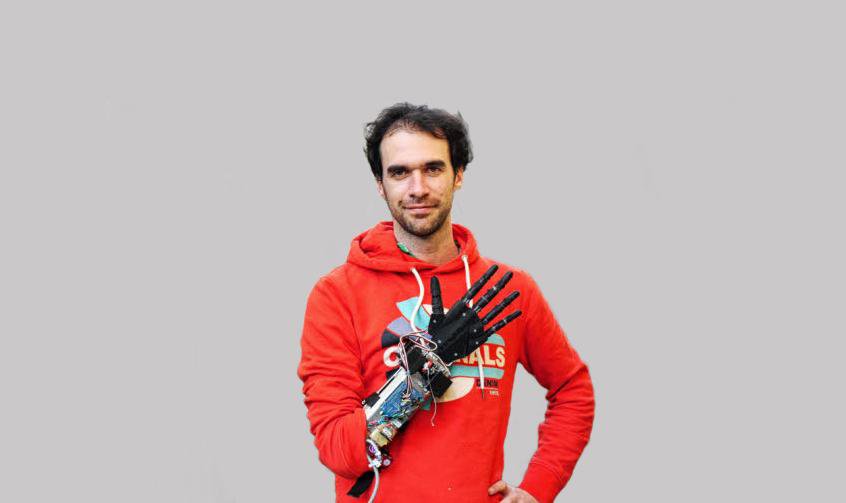
Este proyecto se creó de la mano de Nicolas Huchet en el año 2.012, que tras años de duro trabajo desarrollando el proyecto utilizando herramientas libres, tanto de hardware como de software incluyendo la impresión 3D, dio a luz a BionicHand.
Tras años de buscar prótesis funcionales sin éxito, conoció el proyecto del robot Inmoov (de origen francés) que lo motivó y ayudó para el desarrollo de su Biónico Hand. Esta prótesis es de tecnología mioeléctrica (más tarde veremos qué es eso) permite que sus usuarios hagan 4 movimientos básicos de la mano, es personalizable además de tener un valor de menos de 300€.
Las prótesis que ni se notan, Unlimited Tomorrow
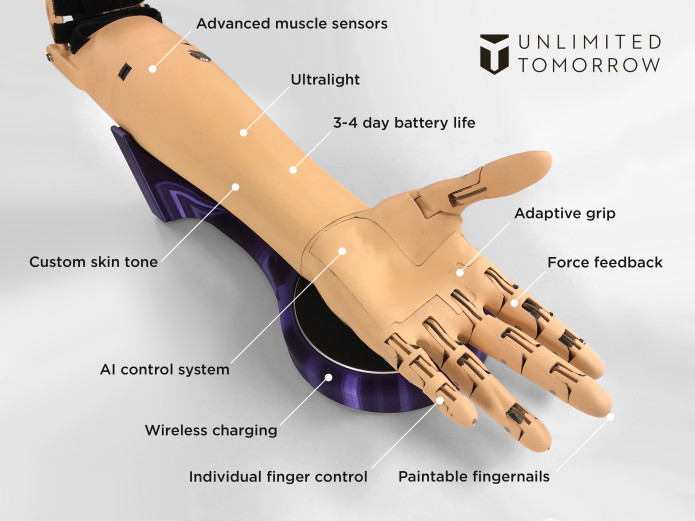
Unlimited Tomorrow fué creada por el joven estadounidense de dieciséis años Easton Lachapelle, que ya llevaba desde hace tiempo haciendo sus pinillos en la impresíon 3D, focalizado sobre todo en la creación de este tipo de prótesis.
Un par de años más tarde crearía la empresa U.T. (Unlimited Tomorrow), una fundación focalizada en la creación de prótesis impresas en 3D de brazos funcionales y sobre todo muy realistas (para minimizar el impacto de los usuarios al llevarlas). Su primer prototipo después de bastantes pruebas de ergonomía salió al mercado en el año 2.017
Prótesis de Pierna, la más compleja de todas
Las prótesis de pierna son las más complejas de hacer con tecnologías libres por una sencilla razón: Es la parte del cuerpo que más peso lleva (contando con el pie, claro). Esto hace que no valga como en los brazos o las manos materiales como hilo de caña de pescar o cinta aislante, necesitamos que los usuarios se sientan seguros con ellas, sino estarán sobre una silla con la pata coja.
Empresas como Unyq tuvieron en cuenta todo esto y a través de la impresión 3D empezó a desarrollar modelos de piernas (también de brazos) totalmente personalizables por el usuario desde el modelo, color, material y obviamente la adaptación total a la anatomía del sujeto o el uso que se vaya a dar de la misma.
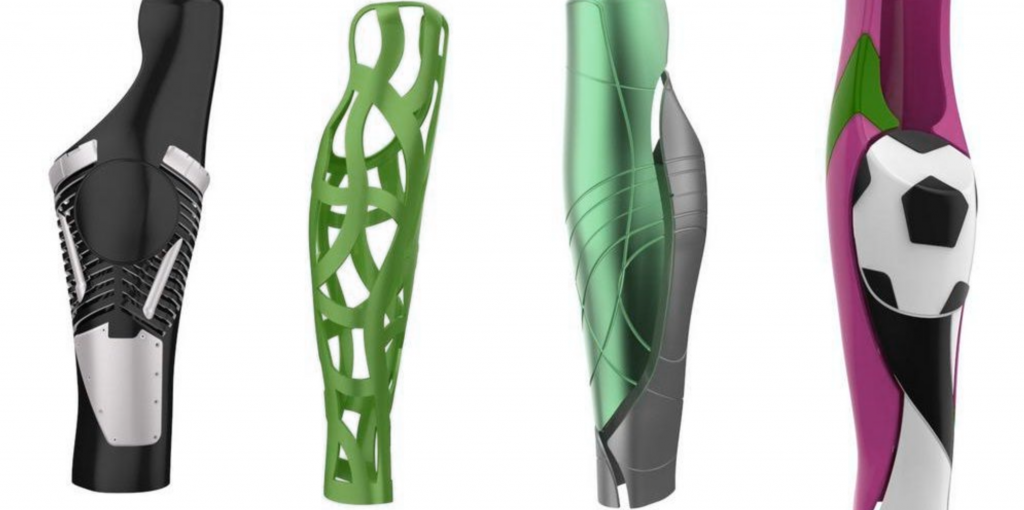
Un ejemplo de este tipo de prótesis puede ser la que llevó la ciclista de origen alemán Denise Schindler, la cual logró ganar la medalla de plata en los juegos paralímpicos de Rio de Janeiro. Dicha prótesis fue creada en conjunto con la empresa Autodesk que se encargó de prácticamente todo el desarrollo.

Prótesis de dedos, microtecnología en estado puro

En cuestiones de prótesis de dedos no hay mejor empresa que Naked Prosthetics, una empresa especializada en ello a través de la impresión 3D. Creada por Colin Macduff a partir de la amputación de uno de sus dedos, éste, a través de la experiencia adquirida en el ejército se lanzó a diseñar un dedo funcional para él mismo.
El nombre de la empresa se traduce como ‘Prótesis Desnudas’ y evoca a una liberación del estigma que sufren los que han tenido amputaciones, creando prótesis funcionales para ellos que les podrán permitir hasta a volver a hacer punteos con una guitarra, o jugar al pingpong.
El desarrollo del producto empieza a partir del envío de las medidas de la zona afectada con ayuda de un médico por parte del cliente. ¡Para que veas la utilidad que tiene la impresión 3D en medicina! A continuación, se empieza el prototipado rápido, haciendo pruebas y fabricando el modelo final con la técnica SLA (estereolitografía). Todo el proceso dura entre 10 y 12 semanas gracias a la impresión 3D.
Prótesis para animales, una buena forma de colaborar
Este punto me encanta, y es que han surgido varias iniciativas para prótesis para animales, que como ya sabrás, se suelen acabar sacrificando cuando ya no pueden moverse. Esto lo cambiaría todo
Una de las primeras iniciativas surgió del joven ingeniero Alejandro Colli, el cual armó una máquina 3D y decidió darle uso haciendo extremidades para perros con miembros amputados y lo mejor de todo, las da gratuitamente. Tarda día y medio en hacerlas y cuestan unos 15 euros.
Otro ejemplo de alto nivel es del del perro Derby en estados unidos el cual nació de una malformación en las patas que le impiden mover la parte inferior. Gracias a la impresión 3D ahora es capaz de correr a través de unas patas con forma de rueda que le permiten impulsarse de forma muy eficiente. El video merece mucho la pena.
Prótesis dentales impresas, cada vez más demandadas
Para mí, uno de los campos donde más futuro hay con respecto a la impresión 3D es el de las prótesis dentales. Conocemos a veterinarios que decidieron comprar una impresora 3D especializada en el tema y ahora venden dientes personalizados a galgos de carreras por aproximadamente 6.000 euros (son casos algo especiales, sus presupuestos suelen ser algo menores).
El procedimiento es muy sencillo, simplemente se escanea el modelo del hueco donde queremos introducir la nueva pieza y lo modelamos con el programa de diseño 3D de la impresora. A continuación, le cargamos el archivo y mediante tecnologías como la estereolitografía se va creando el objeto poco a poco a través de capas del orden de micras.
Lo más caro de este sector (y donde realmente las empresas ganan) no es tanto en las impresoras sino en los materiales que se desarrollan los cuales, tienen que ser inocuos para que el cuerpo del paciente no los rechace.
Mércuris, la empresa especialista en prótesis de pie
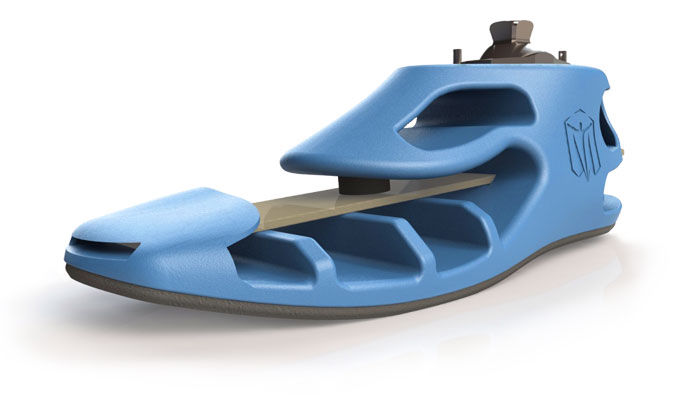
Al igual que otros fabricantes de prótesis para impresión 3D, Mércuris también utiliza esta tecnología para la creación de sus modelos, los cuales están marcados con la certificación de máxima calidad de la Union Europea.
El paciente puede desarrollar su prótesis personalizada a través de la plataforma online de Mércuris, la cual se desarrolla en una semana (que la empresa quiere reducir a dos días). Este fabricante también desarrolla prótesis de pie para niños llamadas FirStep, las cuales podrás ver disponibles en su página web.
¿Qué son las prótesis mioeléctricas?
Las prótesis mioeléctricas son prótesis eléctricas controladas por medio del paciente y de sus músculos (o su contracción), este tipo de prótesis son hoy en día el tipo de miembro artificial con más alto grado de éxito en la rehabilitación.
Sintetizan por un lado un mejor aspecto estético además de tener gran capacidad de fuerza y velocidad prensil, así como muchas posibilidades de combinación, ampliación y personalización.
Cómo puedo ayudar, ONGs que se dedican a las prótesis 3D
Hoy en día existen diversas ONGs que se dedican a la creación de prótesis 3D para los que más lo necesitan y de forma muy económica. Puedes incluso descargar sus modelos de forma completamente gratuita y en algún viaje de voluntariado, poder proponérselo a tus compañeros :). Te dejamos un listado de las más conocidas a nivel mundial y de España.
Ayúdame 3D.org, ¡nuestro proyecto favorito!
Guillermo Martínez fue el promotor de ayudame3D, una organización dedicada a la creación de prótesis low-cost. Ingeniero de organización industrial de profesión y filántropo, ha creado modelos completos, semi completos y de mano funcionales los cuales ha llevado a países africanos para ayudar a los más necesitados.
Puedes ayudarle en su web y fabricar tus propias prótesis para luego donarlas.
E-Nable
E-Nable, con sede fuera de España, es la plataforma más popular dentro del mundo de las prótesis en 3D. Cuenta con una gran comunidad la cual comparte sus proyectos y diseños, se verfícan y muestran cómo los aplicado. Puedes unirte también a través de su página web.
LimbForge
LimbForge es una asociación que tiene como objetivo dar prótesis a países del tercer mundo que a menudo no pueden pagarlos. Ha desarrollado varios modelos de prótesis impresas en 3D para: brazos, codos, antebrazos, muñecas además de manos, con opciones para adaptarse completamente al que los lleva. Después del modelado 3D la prótesis se imprime en 3D a partir de un material plástico que puede tomar un color diferente según el tono de piel del usuario.
Atomic Lab
Atomic Lab es una asociación con sede en Argentina la cual se dedica a poner en contacto a gente que quiere colaborar dando prótesis impresas por ellos, con gente que las necesita. Para poder hacerlo (desde cualquier parte del mundo) ingresa su web. Nunca nadie te pedirá dinero, es totalmente gratis.
Handicap International
Handicap International es una ONG fundada en Francia en 1982 cuyo enfoque es la ayuda de personas con discapacidades y necesitadas. En 2016, Handicap International lanzó una investigación en la que se desarrollaron prótesis de pierna impresas en 3D a través de un escáner 3D que creaba un modelo digital de la parte del cuerpo en concreto, y se la enviaba a una impresora 3D, que la creaba. El objetivo de la organización es ayudar a las personas de los países en desarrollo y las zonas de conflicto a obtener prótesis muy alta calidad.
¿Qué te ha parecido nuestro artículo prótesis de impresora 3D?
En primer lugar, queríamos darte la enhorabuena por llegar hasta aquí, pocos lo hacen, y pedirte que nos dejes en la caja de comentarios qué te ha parecido el artículo. Desde Bitfab tenemos muy en cuenta la opinión de nuestros lectores y nos encantaría saber la tuya.
Si prefieres también puedes echarnos una mano compartiendo este artículo en la redes sociales para que llegue al mayor público posible y todo el mundo conozca cómo se usan las impresoras 3D para hacer el bien! 😊
Las prótesis 3D es una forma de ayudar a los demás a través de la impresión 3D y dar un sentido a nuestra máquina que muchas veces tenemos muerta de risa en un rincón de la habitación.
Una vez más, gracias por llegar hasta aquí. Nos vemos en el siguiente post 🙂

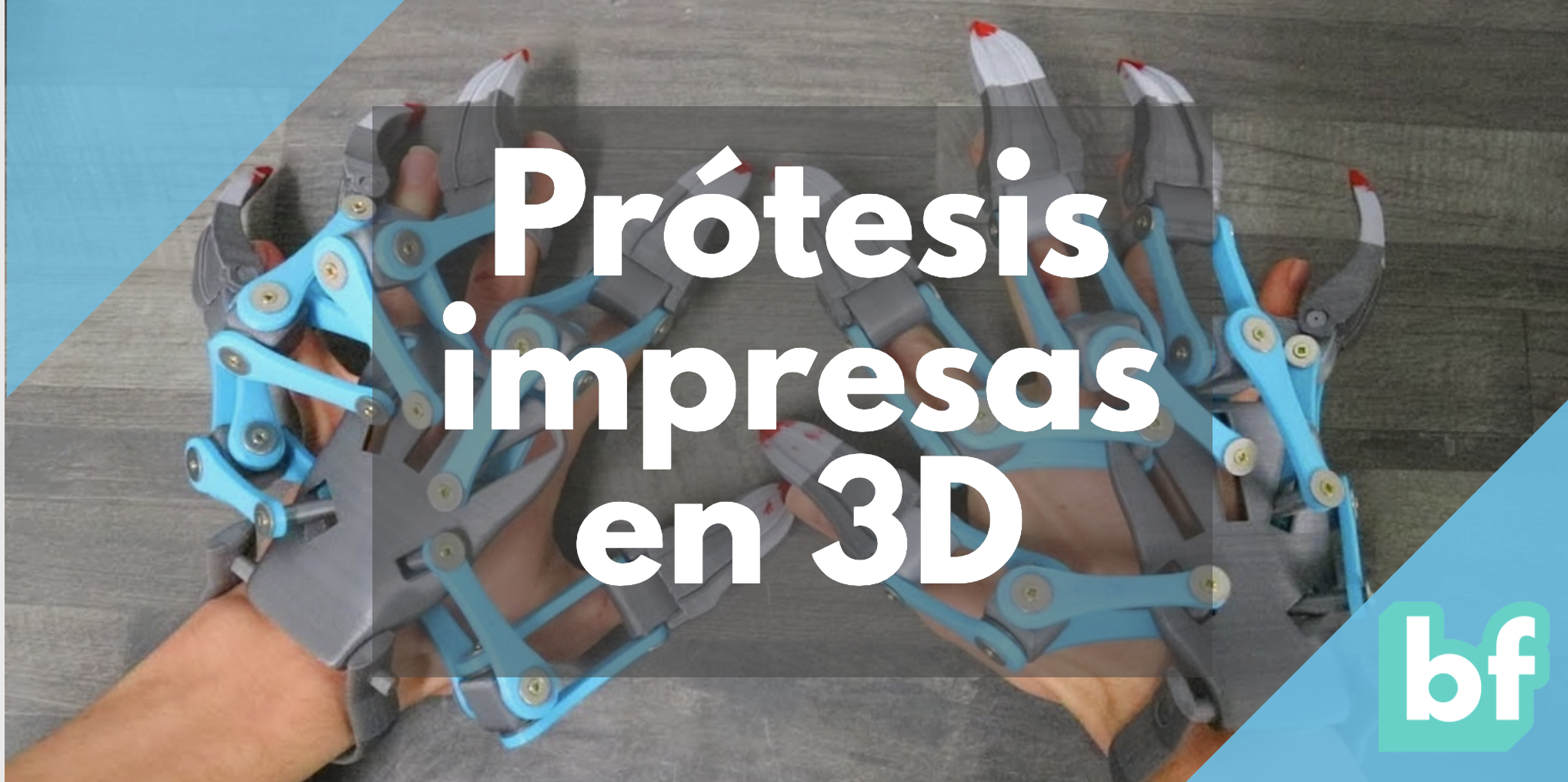

Que maravilla ver como avanza la tecnología en beneficio de quienes lo necesitamos. Gracias a todos lo que invierten su tiempo en fabricar, diseñar prótesis. La vida no vuelve a ser la misma desde que pierdes una extremidad, pero con una prótesis es mucho mejor, espero llegar a tener una.
Me encanta el trabajo que realizan, no solo en seres humanos si no también en animales. Es un cambio de vida tanto para unos como para los otros poder desenvolverse en forma casi normal. El hecho de poder correr o volver a practicar un deporte Le da un sentido a sus vidas. Ojalá yo pudiera aprende a hacerlo para colaborar con ustedes . Son geniales!!!
Todo el mérito a los proyectos que se encargan de hacer las prótesis, nuestro apoyo también.
Excelente artículo. Me surge una duda… Las impresoras 3d utilizadas para fabricar prótesis ¿necesitan alguna certificación especial?
Gracias!!
Las impresoras propiamente no necesitan certificación, pero la empresa o instalaciones en las que realiza la producción tienen que tener una licencia de fabricante de producto sanitario y un sistema de calidad acorde. Esa es la situación legal en España.
Wawww!!! Super muchas gracias por todo la información, la dedicación y por compartir el conocimiento.
Muy buenas Diego.
Gran trabajo,mi pregunta es ¿existe alguna empresa puntera española dedicada a este tipo de prótesis que hagan todo el proceso:diseño,modelado ,escaneado 3d,fabricación y posterior certificación médica del producto?
Muchas gracias y un saludo
No la conozco, pero a lo mejor alguien nos puede ayudar.
Admiro a todas estas personas que están haciendo una ardua labor ayudando desinteresadamente a las personas que necesitan ayuda. Ojalá muchas personas podamos ayudar. Me gustó mucho haberme dado cuenta de que hay muchas personas que necesitan ayuda.